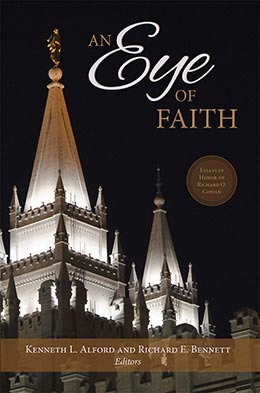Visions of Faith: Early Church Pioneers in Ghana
Kenneth L. Alford and JeanMarie Stewart
JeanMarie Stewart and Kenneth L. Alford, “Visions of Faith: Early Church Pioneers in Ghana,” in An Eye of Faith: Essays in Honor of Richard O. Cowan, ed. Kenneth L. Alford and Richard E. Bennett (Provo, UT: Religious Studies Center; Salt Lake City, 2015), 349–63.
JeanMarie Stewart was an applied mathematics major at Brigham Young University when this article was written.
Kenneth L. Alford was an associate professor of Church history and doctrine at Brigham Young University when this article was written.
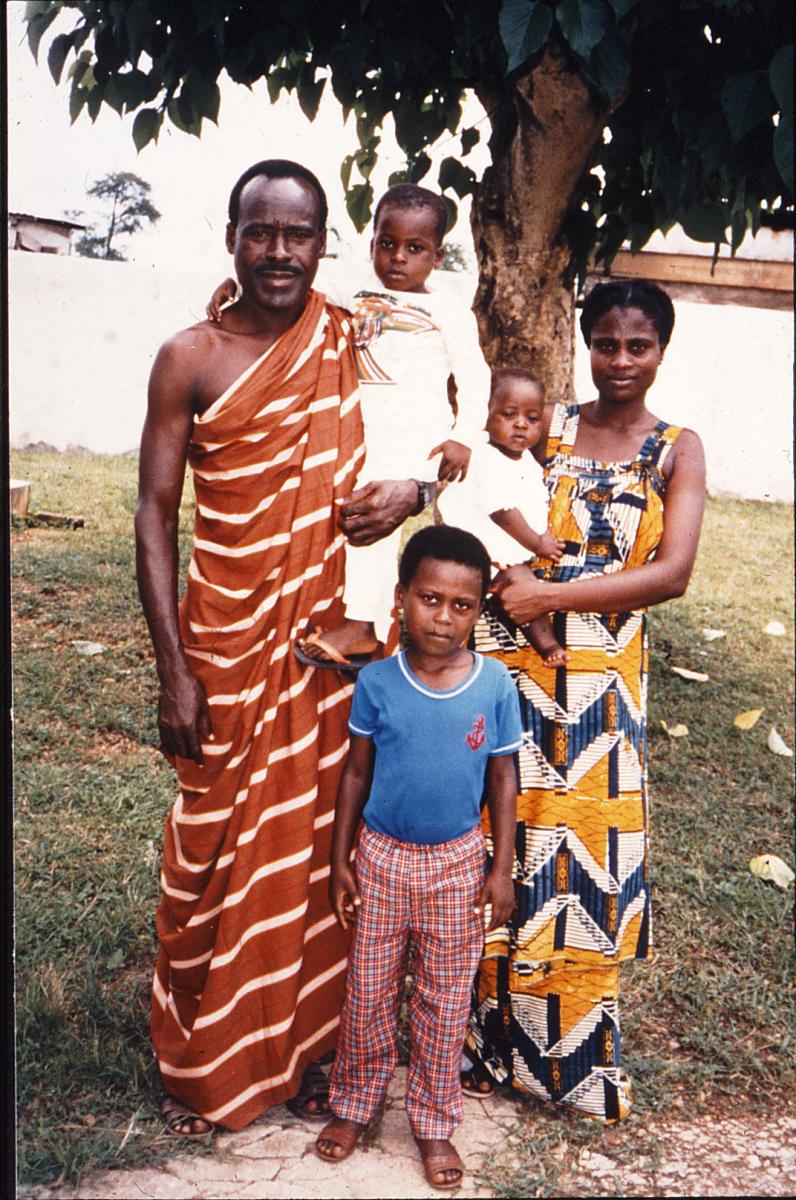 Because the gospel has been taken to Ghana, families can enjoy eternal blessings. (Courtesy of Sherilee B. Alford.)
Because the gospel has been taken to Ghana, families can enjoy eternal blessings. (Courtesy of Sherilee B. Alford.)
During his half century at Brigham Young University, Richard Cowan has taught tens of thousands of students and mentored hundreds more. It seemed appropriate, therefore, that this volume should include at least one mentored-student essay. BYU student JeanMarie Stewart served a successful mission in the Alpine German-Speaking Mission, where she taught numerous Ghanaians. The research associated with this essay was part of a faculty-mentored student grant from the Harold B. Lee Library, and this essay seeks to recognize and honor Richard Cowan’s extensive research and writing on the twentieth-century Church.
God has a unique plan to bring the gospel to his children in Ghana. It began in the fifteenth century, when Ghana, comparable in size to England and located near the equator, began to be heavily influenced by several European countries (Portugal, France, the Netherlands, Denmark, and Great Britain). These countries sought to expand their colonial empires by paradoxically introducing both slavery and Christianity.[1] As the demand for slaves decreased in the early 1800s, Great Britain was left as the sole European power in Ghana.[2] In 1957, as part of the tidal wave of freedom that swept through the British Empire following World War II, Ghana declared independence. Since that time, the country has seen economic ups and downs and a government that has changed hands frequently, occasionally through military coups.
Ghana is a deeply religious country—Christian in the southern portion and Muslim in the north. Religion provides the “fundamental basis of their sense of social identity, values and destiny,”[3] and there is a long tradition of Christian missionaries serving within the country. Rendell Mabey, a Latter-day Saint Church representative who visited West Africa in 1978, described the people of the region as “soil so fertile, in the words of an old-time farmer, it would ‘almost jump up and grab the seeds from your hand.’”[4]
This essay shares illustrative examples of the Lord working through inspired people to help Ghanaians find and establish the Church. Many of the stories included are appearing in print for the first time. In an effort to add additional depth to this interesting history, we will look at some of the people who were influential in bringing the gospel to Ghana in the years prior to Official Declaration 2 (which extended the priesthood to all worthy men), provide a glimpse into the service of full-time senior missionaries, and share the stories of some of the Ghanaians who were converted and served faithfully as the Church was being established there.[5] The experiences presented here represent only a fraction of the stories yet to be told.
Before Official Declaration 2
The Church of Jesus Christ of Latter-day Saints was not formally organized in Ghana prior to the announcement of Official Declaration 2 in 1978, but that did not stop several well-intentioned individuals from organizing branches of the Church without authorization and doing the best they could to follow Church teachings. Dr. Raphael Abraham Frank Mensah was one of the first Ghanaian converts to the gospel. He was introduced to the Church by way of a tract received in 1962 from a friend who was visited by sister missionaries in England.[6] Dr. Mensah was quickly converted and wasted no time establishing a Latter-day Saint congregation in Accra, Ghana, to share his newfound religion.
One of Mensah’s early converts was Joseph William Billy Johnson. Dr. Mensah gave Johnson a copy of the Book of Mormon in 1964, and Johnson became convinced of its truthfulness. He said, “As I read the Book of Mormon I became convinced that it was really the word of God, and sometimes while reading I would burst into tears. I felt the Spirit as I read. . . . I have a strong testimony [of] the Book of Mormon. It is a very powerful book!”[7] Johnson knew there was much he could do to help the work in Ghana. This feeling was confirmed by a dream he had wherein the Lord called him to share the message of the Book of Mormon. Johnson recalls that one night he heard a voice saying “Johnson, Johnson, Johnson. If you will take up my work as I will command you, I will bless you and bless your land.” To this call Johnson replied, “Lord, with thy help I will do whatsoever you will command me.”[8]
Over the next fourteen years, Johnson “became a colorful, tireless missionary for the Church, going wherever the Spirit directed.”[9] He preached tirelessly, telling everyone who would listen about the gospel. He did the best he could with the resources available and was able to organize several unofficial branches. But he still longed to have official contact with the Church. Additionally, he was met with hardship as “he and his followers were . . . persecuted, with people ‘hooting’ at them and ridiculing them.”[10] Nevertheless, Johnson taught many people about the restored gospel. By 1978 he was the leader of seven congregations with five hundred to a thousand total members.[11] Johnson surpassed even Mensah, who had faded from his leadership role in the Latter-day Saint groups.[12]
Ghana’s early gospel pioneers did the best they could without priesthood authority. In due course, the time came for the priesthood to be extended to all worthy male members, and the door for official missionary work in Ghana opened wide.
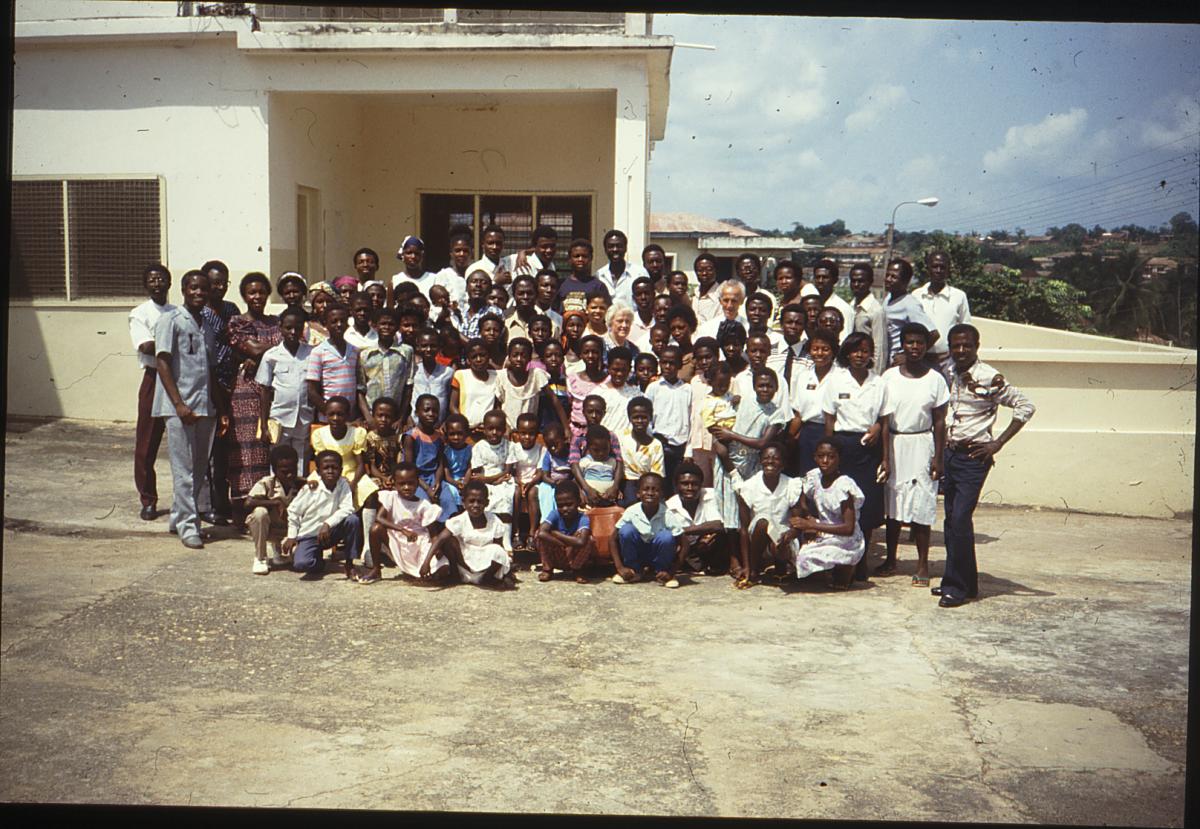 Congregation of Latter-day Saints in southern Ghana in 1987. (Courtesy of Sherilee B. Alford.)
Congregation of Latter-day Saints in southern Ghana in 1987. (Courtesy of Sherilee B. Alford.)
After Official Declaration 2
In 1978, Spencer W. Kimball, President of The Church of Jesus Christ of Latter-day Saints, received a revelation regarding priesthood availability—all worthy male members of the Church could hold the priesthood. After Church leadership announced Official Declaration 2 in June, the gospel quickly took root in Ghana. Those in Ghana who had already accepted the gospel received the news with great joy. J. W. B. Johnson learned of Official Declaration 2 late one night in July 1978: he had difficulty sleeping one evening so he turned on the radio. Then he heard a BBC news announcement that the Church was extending the priesthood to all worthy males.[13] Overcome with emotion, he reported that he just “sat there and cried.” In early September, he sent a letter to President Kimball explaining that “God has prepared the groups in Ghana for you; for we have nowhere else to go, but look forward to your sending to us missionaries to help us understand the Church better; for it is our burning desire to live by the faith of this Church.”[14]
The Church granted Johnson’s wish and sent the needed missionaries. The first official missionaries from the Church arrived in Ghana in November 1978, and the first branch was officially organized just one month later. Many Ghanaians were eager to be baptized, and baptisms were performed in a wide variety of places, from the ocean to small pools of water so shallow that the person being baptized had to be seated in the water.[15] Johnson was ordained to the priesthood and called as the first branch president and shortly thereafter as the first district president in Ghana.
The Church also began to officially organize groups and teach the Ghanaians how to conduct meetings. Previous to the missionaries’ arrival in Ghana, church services were conducted in a manner that was not aligned with official practices of the Church. The members incorporated drums, dancing, and other aspects of traditional African worship into their services. Charles Kofie Ansah shared that “after a prayer we would stand up and sing shouts for about 10 or 20 minutes, then we would sit down and a portion of the gospel would be read to us. We had the singing and the dancing in between other things.”[16] When missionaries arrived, they taught the Ghanaians how to conduct sacrament meetings and gave them priesthood authority to administer ordinances. Some members found the changes introduced by missionaries hard to accept. Ansah, who was called as a branch president, was challenged by some of his members who clung to the previous ways of doing things. During one sacrament meeting, some members suddenly “started the shouts and so forth. We told them we wouldn’t allow it but they still persisted. . . . After the meeting we told them, ‘look, if you want this you should ask the missionaries, tell them what you want because we didn’t impose the changes on you.’ . . . But they wouldn’t accept it and just continued doing their thing.” Many members accepted the changes and remained faithful, but some did not and left the Church.[17]
Among the members who saw the blessings of the changes was Abraham Gofred Dadzie, a member who was baptized in 1978 upon the arrival of the first missionaries. He noticed the difference that real priesthood authority made in his life. Abraham and his family had been attending Latter-day Saint meetings before the missionaries arrived. After the missionaries arrived, he observed: “When I was made a deacon I was more excited because I wasn’t impressed about what we had been doing and after the real way of worship had been introduced into the church I was very happy and learned a lot. Having that priesthood of being a deacon gave me the privilege of serving the Lord. As I passed the sacrament, this also helped me to change my life; . . . bit by bit I was able to keep most of the commandments that actually qualified me to pass the sacrament. As I did this I saw that gradually my life changed.”[18]
Within a year, over four hundred members had been baptized, and by 1981 there were seven branches in Ghana.[19] Missionary work progressed and the Africa West Mission was organized in 1980, followed by the Ghana Accra Mission in 1985.[20] Missionary work in Ghana focused on “training local leadership, which is made easy because members in Africa are eager to be taught and quick to learn and abide by gospel principles.”[21] The perfect people to help the Ghanaian members were senior missionary couples who had the experience necessary to help new members learn their responsibilities. In the years following the organization of the Ghana Accra Mission, many senior missionary couples served in Ghana, teaching, training, and helping the members build up the Church.
One such couple was Dean and LaBelle Bond from Ogden, Utah. When the Bonds served their mission in 1987 and 1988, the Church was still young in Ghana, and the members were fairly recent converts. The Bonds and other senior missionary couples were a steadying influence and had a positive effect on the branches where they served. In the front of her missionary journal, LaBelle Bond recorded a new verse for the missionary anthem “Called to Serve” that helps to capture some of that early missionary enthusiasm:
Called to serve, the greatest mission ever
Ghana, Accra, servants of the Lord
While we seek his other sheep to gather
We all work with one accord
Chorus:
Onward ever onward
From Kumasi to Moree
Onward, ever onward
From the jungle to the sea
Forward, pressing forward
Are Ghanaians dressed in white
In the rivers or the ocean
We will baptize day or night.[22]
While serving as a senior missionary couple in Ghana, the Bonds saw many people who were ready to enter the waters of baptism. As Dean Bond noted in his journal:
There were baptismal services this weekend in the district with seven at Aso-Kwa, three at Kumasi and four in Nwamasi. That makes fourteen in a two week period which isn’t too bad for just one district. Since there are seven districts in the Ghana Mission and Kumasi is one of the low baptizers it means that the mission is baptizing close to 150 per month. This puts a real burden of action on the leaders to have branches staffed with competent leaders, teachers and presidencies in all places they are needed. We are acting as support and council [sic] in all areas where we can function within the priesthood correlation framework.[23]
Ghanaians were ready to embrace the gospel, but they were unfamiliar with Church operations and responsibilities. Elder Bond worked closely with Church leaders to help them organize branches that could function on their own. Progress was slow, but thanks to local Ghanaian members who were in tune with the Spirit, headway was made in organizing local branches. The Bonds and many other senior missionary couples like them were truly “ministering angels to grateful, loving people.”[24]
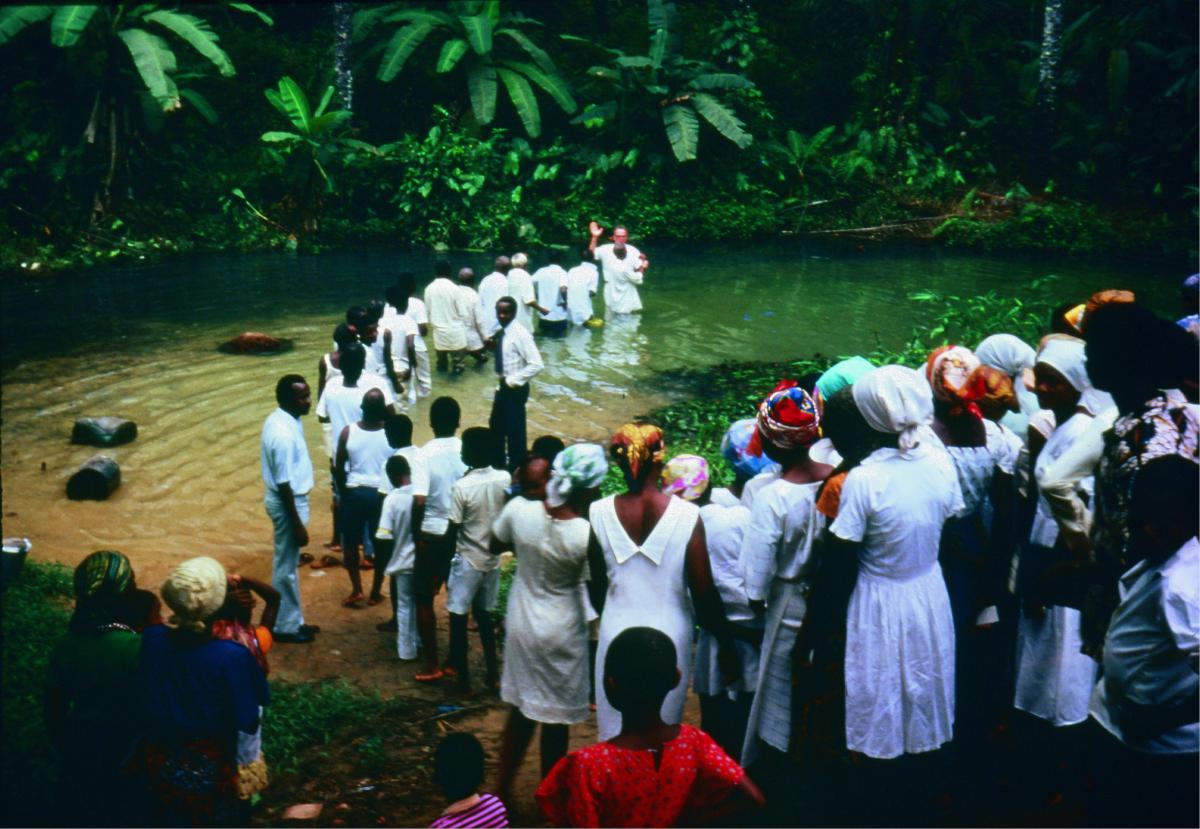 A group of West Africans dressed in white being baptized by Edwin "Ted" Q. Cannon Jr. (Photo by Janath R. Cannon.)
A group of West Africans dressed in white being baptized by Edwin "Ted" Q. Cannon Jr. (Photo by Janath R. Cannon.)
Examples of Conversion and Continuing Service
The loving members in Ghana each had their own unique conversion story. Many Ghanaians were prepared beforehand by the Lord to accept the gospel; he opened paths so they could find answers to gospel questions they had been asking all their lives. One member who found answers in the restored gospel was Emmanuel Dei Anin, who later served as a district president in Kumasi, Ghana. When he was nineteen or twenty years old, he had a dream where he felt he was in serious danger and called out to Jesus for rescue. After that dream, he felt that there was more to life than he was taking advantage of, and he actively searched to find the true church. When he found The Church of Jesus Christ of Latter-day Saints, he did not hesitate to do everything that was asked of him. He was baptized within a few weeks after he first attended Church, and he progressed quickly in the gospel. He recalled later, “[One month after baptism] I was asked to give a talk at sacrament meeting which I did and did well. After my talk a lot of people gave me a handshake and told me I did well so about four months later I was made an elder and called to be an instructor in the Elders Quorum, I had that call for about three months then I was released and became a district mission president. Later, at a district conference, President Cunningham called me and said the district was not functioning and that he wanted me to be in the district presidency so I was called as a first counselor to the district president. In May of 1987 I was called as a district president.”[25] Emmanuel’s experience was typical of many Ghanaian converts; because the Church in West Africa was just taking root, new members needed to step up and assume responsibility shortly after their baptisms.
Another way that Ghanaians found the Church was through acts of kindness. Holbrook C. MacArthur, who would later become a bishop, performed such an act of kindness that led him to the Church. While walking down the street, he saw two women struggling to get a very ill man into a car, and MacArthur offered to help take the man to his destination. The women were going to see J. W. B. Johnson, a Latter-day Saint, to ask him to pray for the man. This was before missionaries arrived in Ghana, but Brother Johnson had a reputation for being able to help those who were afflicted. MacArthur helped take the ill man to Brother Johnson, and MacArthur was surprised by what Brother Johnson told him. He recalled, “Brother Johnson asked me whether I was a friend of those people and [I] explained that I wasn’t. He was pleased with the kindness I showed and he gave me some pamphlets on the church and told me that his church was the only true church on earth. I wasn’t very pleased with that statement because I was then a Catholic but when I went home and read through the pamphlets, I felt the need to have more information about the church.”[26] MacArthur was convinced of the truthfulness of the gospel and began worshipping with Brother Johnson’s group. He embraced the opportunity to be baptized when missionaries arrived in Ghana. Later, when he was asked to choose which doctrine of the Church had the most impact on his life, he replied, “All of them, all of them touch my heart.”[27]
Many Ghanaians drastically changed the way they lived their lives after becoming converted to the gospel. The restored gospel brought more truth and light into their lives that helped them to see that there was a better way to live. Annoh George Abu expressed this sentiment when he said, “They teach you to understand unlike the other church I had gone to before, that church didn’t teach us to understand and because of that I didn’t go to church often. However, since I joined this church I haven’t been absent one day.”[28] Abu found the answers to his questions. He was finally taught to understand, and he wasn’t going to let go of that knowledge.
Other Ghanaians changed their lives by stopping the destructive behavior that had previously controlled them. Kweku Akuam recognized how free the gospel had made him when he visited some old friends who were struggling with alcohol. He noticed that “all of them were complaining that they wanted to stop drinking. I could see that they were helpless and this was something I was absolutely in control of. They saw the drinks and they wanted to stop but the drinks sort of pulled them and they went in for more and more. I could see that this was nothing that would tempt me.”[29] Akuam became another powerful example of how the Lord can change lives.
Among many other conversion stories, dreams also often figured prominently. When Kofi Kwequir-Aggrey’s wife started investigating the Church, Kwequir-Aggrey was resistant to the missionaries and often avoided them during visits at his home. However, all that changed. As he explained, “I had a dream that there were a lot of people in a crowded room, and there was a bulb in the room but nobody to fix it. Everyone suggested ‘Well, why don’t we lift you up and you fix the bulb so that we can have light?’ They lifted me up, and I fixed the bulb, and as I fixed the bulb there was joy; everybody in the room shouted for joy. I figured that maybe I have a part to play in order for some people to have the light and see about them. I told my wife about the dream. . . . I accepted the call for baptism.”[30] His first calling was as the branch mission leader; eight months later he was called to be a branch president.
Other conversion stories were less dramatic. Thomas Kwamena Appiah’s father met the missionaries in America and gave his name to a senior couple called to Ghana on a mission. It took the Church three years to locate the family again, but when they did, Thomas listened to the missionaries’ message with rapt attention. He soon gained his own testimony of the truthfulness of the gospel. He recalled that after praying one day, he “had a sweet confirmation of the truths. I didn’t have any sort of dramatic visitation of God the Father and his Son Jesus Christ. No, nothing like that, but I knew for myself that what I was reading was very true. And so the next visit when the missionaries came I expressed my desire to hear more.”[31] As soon as he felt the Spirit confirming the truth of what the missionaries said, he wanted to share it with others. After baptism, he started an LDS group at the university he was attending and felt the desire to serve a full-time mission. After receiving his mission call, he expressed his willingness to serve by affirming: “Yes, I have been called of God to go and serve. So I will leave, I will go and serve.”[32]
After conversion, many other Ghanaian members dedicated themselves to the Church. Juliana Anno discovered the Church while visiting Joseph Smith’s birthplace in Sharon, Vermont, and had been baptized only a short while when she felt the gentle but persistent prodding of the Spirit to share the truth she had found. She returned home to Ghana to share the feeling of the Spirit with the rest of her family. After returning home she told her children, “What you have been asking all the time I have now found the answer to. . . . If there’s a church like that, then we are all going to join.”[33] It took Juliana two years to locate the Church again in Cape Coast, Ghana. One of the things that impressed her most about the gospel was learning how to pray. She recalled, “When we attended the conference they taught us simply how to pray. Maybe I didn’t listen to my parents but nobody had taught me how to pray. All I knew was to say Our Father or the Hail Mary, that’s all. They taught us how to pray and that impressed me very much.”[34] Juliana learned how to talk to her Father in Heaven, a skill that helped her when she served as a district Relief Society president helping Ghanaian sisters learn and grow in the gospel.
Once converted, Ghanaian members were blessed by their ability to be in tune with the Spirit. In 1988, a Ghanaian branch president in Oda shared the following story, as recounted by Dean Bond:
We had fast and testimony meeting today and one testimony was by Branch President Alphonse Amawwho, who said that he went to his farm alone about 3:00 p.m. intending to return home about 8:00 p.m. On the farm they had built a small shack to use as a rest area and for shade. He had worked until about seven o’clock and was resting in the shelter when he had the prompting to go home. He put it off once and it came again and he heeded it this time and started for home. As he arrived home he noticed a strong wind blowing. The next morning a[t] 3:00 a.m. he returned to the farm to finish the work he had started the night before. Upon arriving he noticed that the rest shack had been smashed by a tree that had blown down.
Elder Bond added: “It is the same kind of story Wilford Woodruff told as he was prompted to move his buggy that would have been smashed by a falling tree. We all need to heed the promptings of the Holy Ghost. I know that I need to be more in tune with the spirit. I pray that we may all follow the spirit more closely.”[35]
Amawwho was able to recognize the Spirit’s voice because he had heard it before. As a result of his faith, the Lord was able to reach out his hand and save him from danger. The Lord used faithful Ghanaian members as tools in his hands to build up the kingdom in Ghana and bring the truth of the restored gospel to those who had been missing it in their lives.
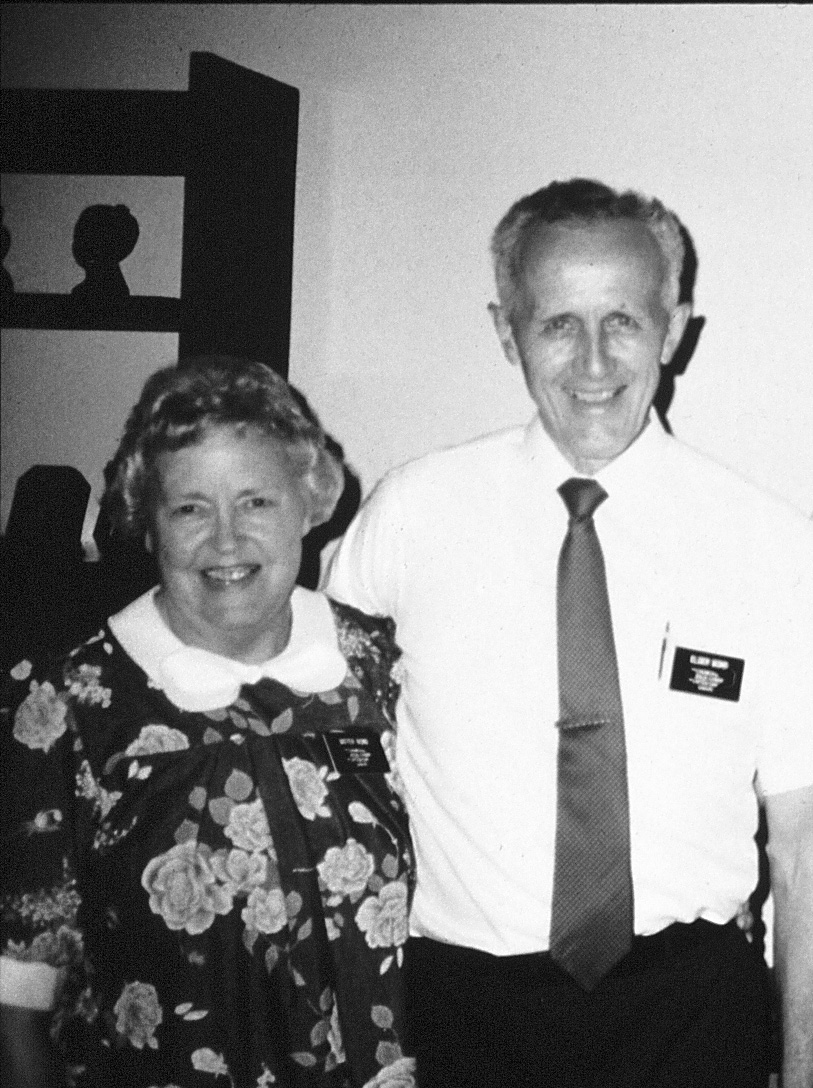 LaBelle and Dean Bond, from Ogden, Utah, served as missionaries in the Ghana Accra Mission during 1987 and 1988. (Courtesy of Sherilee B. Alford.)
LaBelle and Dean Bond, from Ogden, Utah, served as missionaries in the Ghana Accra Mission during 1987 and 1988. (Courtesy of Sherilee B. Alford.)
Conclusion
The history of the Church in Ghana is the story of people of faith. Gospel seeds planted before Official Declaration 2 blossomed in the years that followed as early pioneers and missionaries established the Church there. The stories shared here highlight a few of those people. As Holbrook C. MacArthur, one of the first bishops in Ghana, said: “I think the most important thing I can say now is growth. Before the missionaries came it was just a small group and wasn’t expanding or growing but after the missionaries came we grew. . . . What I can say now is that the gospel of the truthfulness of everything is spreading, growing, and going everywhere.”[36]
Growth continued after Official Declaration 2 despite several obstacles. Ever suspicious of Americans, in 1989 the Ghanaian government banished expatriate missionaries and prohibited the Church from holding meetings. What followed was an eighteen-month ban on the Church known as “the Freeze.” Latter-day Saints in Ghana did the best they could, holding Church meetings in their homes and relying on each other for support.[37] A time of testing, it was “as if the Church had been placed in a refiner’s crucible and the chaff perished with time and intensified heat. The gold was, however, refined and remained pure in the end. . . . Those who had strong enough testimonies to stay faithful were refined while they remained steadfast and endured that strong wave of persecution to the end.”[38] The Church resumed its rapid growth following the lifting of the Freeze. Today there is a house of the Lord in the capital, Accra, and stakes of Zion increasingly dot the landscape. As the Apostle Peter taught, “God is no respecter of persons. But in every nation he that feareth him, and worketh righteousness, is accepted with him” (Acts 10:34–35). The gospel reached Ghana over a long and winding road, but Ghanaians continue to look to the future with faith and courage.
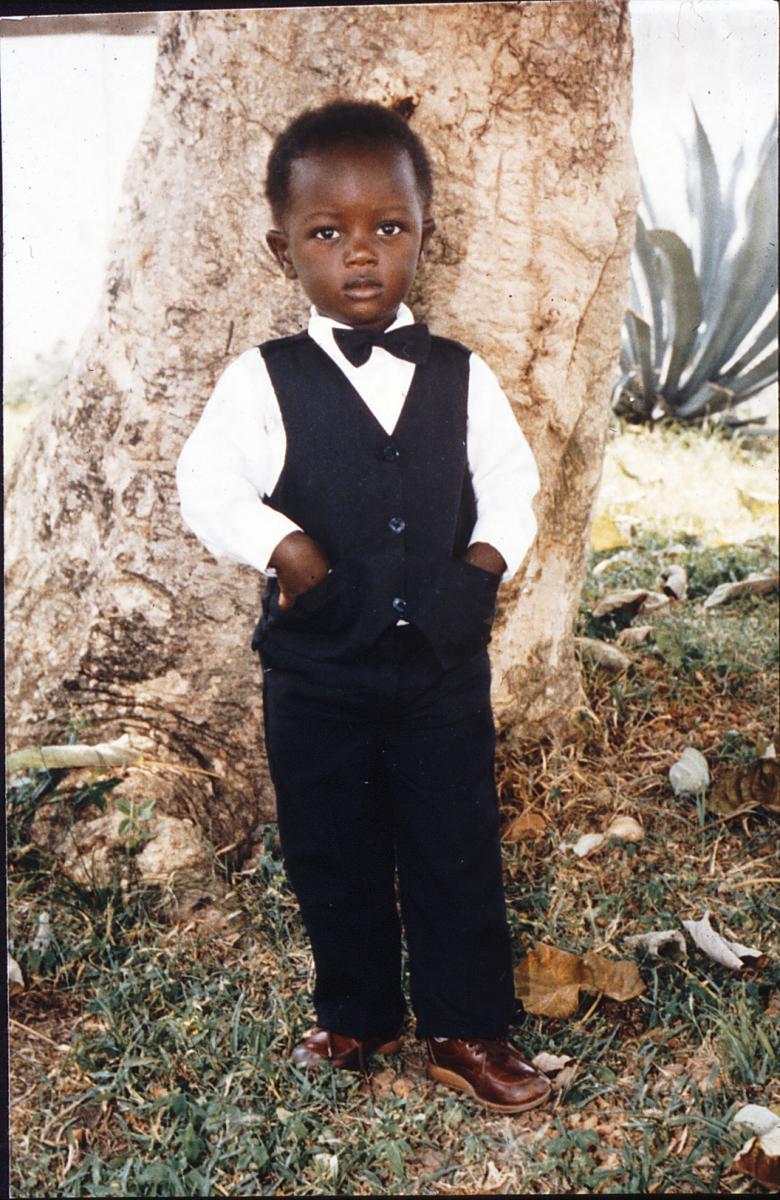 Official Declaration 2 would have a great impact on the life of this young Latter-day Saint boy in Ghana. (Courtesy of Sherilee B. Alford.)
Official Declaration 2 would have a great impact on the life of this young Latter-day Saint boy in Ghana. (Courtesy of Sherilee B. Alford.)
Notes
[1] William Lye, “From Burundi to Zaire: Taking the Gospel to Africa,” Ensign, March 1980, 13.
[2] John Kuada and Yao Chachah, Ghana: Understanding the People and Their Culture (Accra, Ghana: Woeli Publishing Services, 1999), 20.
[3] Kuada and Chachah, Ghana, 36.
[4] Rendell Mabey, quoted in James B. Allen, “Would-Be Saints: West-Africa Before the 1978 Priesthood Revelation,” Journal of Mormon History 17, no. 1 (1991): 210.
[5] This essay draws on an oral history collection recorded by BYU professor E. Dale LeBaron that is archived in the L. Tom Perry Special Collections, Harold B. Lee Library, Brigham Young University, Provo, UT, as well as previously unpublished missionary journals.
[6] Allen, “Would-Be Saints,” 239.
[7] Joseph William Billy Johnson, quoted in E. Dale LeBaron, “African Converts without Baptism: A Unique and Inspiring Chapter in Church History,” in 1998–1999 BYU Speeches of the Year (Provo, UT: Brigham Young University Publications, 1999), 57–66.
[8] Johnson, quoted in LeBaron, “African Converts without Baptism,” 7.
[9] Allen, “Would-Be Saints,” 240.
[10] Allen, “Would-Be Saints,” 240.
[11] Emmanuel Abu Kissi, Walking in the Sand: A History of the Church of Jesus Christ of Latter-day Saints in Ghana (Provo, UT: Brigham Young University Press, 2004), 26. This excellent monograph documents much of the early history of the Church in Ghana and is recommended reading.
[12] Kissi, Walking in the Sand, 25.
[13] Kissi, Walking in the Sand, 28.
[14] Joseph William Billy Johnson, quoted in Kissi, Walking in the Sand, 28.
[15] Kissi, Walking in the Sand, 39.
[16] Charles Kofie Ansah, oral history, interview by E. Dale LeBaron, May 21, 1988, MSS 1937, box 1, folder 24, L. Tom Perry Special Collections.
[17] Charles Kofie Ansah, oral history.
[18] Abraham Gofred Dadzie, oral history, interview by E. Dale LeBaron, May 14, 1988, MSS 1937, box 3, folder 5, L. Tom Perry Special Collections.
[19] Kissi, Walking in the Sand, xxvii.
[20] Church News, 1997–1998 Church Almanac (Salt Lake City: Deseret News, 1996), 331.
[21] James O. Mason, “The Kingdom Progresses in Africa,” Ensign, November 1994, 30.
[22] LaBelle Bond, diary, May 1987, in author’s possession.
[23] Dean Bond, diary, September 27, 1987, in author’s possession.
[24] Mason, “The Kingdom Progresses in Africa,” 30.
[25] Emmanuel Dei Anin, oral history, interview by E. Dale LeBaron, May 23, 1988, MSS 1937, box 1, folder 20, L. Tom Perry Special Collections.
[26] Holbrook C. MacArthur, oral history, interview by E. Dale LeBaron, May 22, 1988, MSS 1937, box 4, folder 13, L. Tom Perry Special Collections.
[27] Holbrook C. MacArthur, oral history.
[28] Annoh George Abu, oral history, interview by E. Dale LeBaron, May 25, 1988, MSS 1937, box 1, folder 1, L. Tom Perry Special Collections.
[29] Kweku Akuam Anno, oral history, interview by E. Dale LeBaron, May 15, 1988, MSS 1937, box 1, folder 22, L. Tom Perry Special Collections.
[30] Kofi Kwequir-Aggrey, oral history, interview by E. Dale LeBaron, May 12, 1988, MSS 1937, box 4, folder 10, L. Tom Perry Special Collections.
[31] Thomas Kwamena Appiah, oral history, interview by E. Dale LeBaron, December 6, 1990, MSS 1937, box 2, folder 1, L. Tom Perry Special Collections.
[32] Thomas Kwamena Appiah, oral history.
[33] Juliana Anno, oral history, interview by E. Dale LeBaron, May 15, 1988, MSS 1937, box 1, folder 21, L. Tom Perry Special Collections.
[34] Juliana Anno, oral history.
[35] Dean Bond, diary, April 3, 1988, in author’s possession.
[36] Holbrook C. MacArthur, oral history.
[37] Kissi, Walking in the Sand, 200.
[38] Kissi, Walking in the Sand, 203–4.
